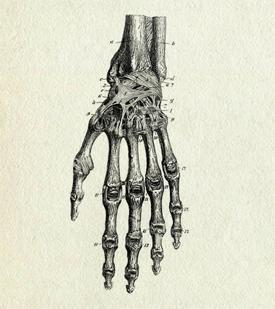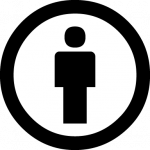
Image adapted from Vintage Collective under a Creative Commons license: BY.
This sequence presents the fundamental principles of muscle physiology and clinical problems of abnormal muscle physiology. Students learn to understand the processes involved in development of the musculoskeletal system and commonly encountered developmental abnormalities. Students will be able to identify the anatomical components of the musculoskeletal system and understand their functions, important relationships, and associated common clinical problems.
Sequence Director:
Thomas Gest, Ph.D.
dScribe: Anthony Grech
Syllabus
General Themes
- Muscle Physiology
- Muscle Metabolism
- Histology of the musculoskeletal system
- Gross Anatomy of the musculoskeletal system
- Radiology of the musculoskeletal system
Overall Sequence Intended Learning Outcomes (ILOs)
Knowledge
- Understand the fundamental principles of muscle physiology and clinical problems of abnormal muscle physiology.
- Understand the biochemical basis of muscle metabolism and clinical issues of abnormal muscle metabolism.
- Be able to identify the cells and tissues of the musculoskeletal system and understand their functions, important relationships, and associated common clinical problems.
- Be able to identify the anatomical components of the musculoskeletal system and understand their functions, important relationships, and associated common clinical problems.
- Understand the fundamental principles and applications of modern imaging techniques and be able to identify normal musculoskeletal anatomy using common clinical imaging modalities.
Skills
- Become proficient at recognizing the cells and tissues of the musculoskeletal system.
- Become proficient at anatomical dissection and recognition of anatomical structures.
- Become proficient at recognizing anatomical structure using common imaging modalities.
- Become proficient at presenting anatomical and clinical information in a concise and precise manner.
Professionalism
- Approach peer teaching with commitment to quality and responsibility to peers.
- Approach peer evaluation with responsibility and commitment to quality improvement.
- Approach human dissection with commitment to learning and respectful treatment of body donors.
Faculty for the Musculoskeletal sequence
- Thomas R. Gest, PhD, Sequence Director - Associate Professor of Anatomical Sciences
- Andrew Barnosky, MD - Clinical Assistant Professor of Emergency Medicine
- Catherine Brandon, MD, MS - Assistant Professor of Radiology
- Clifford L. Craig, MD - Clinical Associate Professor of Orthopedic Surgery
- David Jamadar, MD - Clinical Associate Professor of Radiology
- Sun-Kee Kim, PhD - Associate Professor of Cell and Developmental Biology
- Lawrence R. Kuhns, MD - Professor of Radiology
- Lisa Larkin, PhD - Associate Research Professor of Physiology
- Paul A. Weinhold, PhD - Professor of Biological Chemistry
Required Experiences
In the Musculoskeletal sequence there are several required experiences. In the RARE circumstance where a student cannot attend, the student must contact their class counselor in advance (or as soon as possible in an emergency) to request a deferral. (Please do NOT contact sequence directors with requests for or explanations of deferrals.) Absences will be approved or denied by class counselors based on the same guidelines used for Quiz and Exam deferrals. Should you obtain a deferral from your class counselor, make up instructions for the required experiences (found below) should be followed.
For the Required Patient Presentations, the remediation will be watching the video and a 2-page response paper describing the patient presentation. This must be submitted to Dr. Gest.
For the Physiology Small Groups, the remediation will be writing answers to the small group question. This must be submitted to Dr. Metzger.
Grading
There will be 2 quizzes and a final exam for the musculoskeletal sequence. On the quizzes, there will be 2 or 3 questions from each lecture or learning module of that week. There will both written and practical portions of the final exam. On the written portion of the final exam, there will be approximately 2 questions from each lecture or learning module already covered on a quiz, and approximately 4 questions from each lecture or learning module given in the week of the final exam. On the practical exam for gross anatomy, there will be approximately 4 questions for each laboratory session.
All quiz and exam questions are worth 1 point. All points will be added together at the end of the sequence, and a minimum of 75% will constitute a passing grade.
Learning Outcomes
Knowledge
- Understand the fundamental principles of muscle physiology and clinical problems of abnormal muscle physiology.
- Understand the biochemical basis of muscle metabolism and clinical issues of abnormal muscle metabolism.
- Be able to identify the cells and tissues of the musculoskeletal system and understand their functions, important relationships, and associated common clinical problems.
- Be able to identify the anatomical components of the musculoskeletal system and understand their functions, important relationships, and associated common clinical problems.
- Understand the fundamental principles and applications of modern imaging techniques and be able to identify normal musculoskeletal anatomy using common clinical imaging modalities.
Skills
- Become proficient at recognizing the cells and tissues of the musculoskeletal system.
- Become proficient at anatomical dissection and recognition of anatomical structures.
- Become proficient at recognizing anatomical structure using common imaging modalities.
- Become proficient at presenting anatomical and clinical information in a concise and precise manner.
Professionalism
- Approach peer teaching with commitment to quality and responsibility to peers.
- Approach peer evaluation with responsibility and commitment to quality improvement.
- Approach human dissection with commitment to learning and respectful treatment of body donors.
Schedule
Lectures and Laboratories
10/6 - Introduction to Sequence
Anatomy
10/6 - Gross Anatomy Laboratory: Superficial Limbs
10/7 - Self Directed Learning: Movements of the Upper Limb
10/7 - Gross Anatomy Laboratory: Axilla & Arm
10/9 - Gross Anatomy Laboratory: Forearm
10/14 - Gross Anatomy Laboratory: Hand
10/15 - Self Directed Learning: Movements of the Lower Limb
10/15 - Gross Anatomy Laboratory: Anterior & Medial Thigh
10/16 - Gross Anatomy Laboratory: Hip, Posterior Thigh & Leg
10/20 - Gross Anatomy Laboratory: Anterior Leg & Foot
10/21 - Self Directed Learning: Introduction to Joints
10/21 - Gross Anatomy Laboratory: Joints of the Upper & Lower Limbs
Physiology
10/6 - Muscle Structure/Mechanics
10/7 - Excitation/Contraction
10/8 - Motor Units
10/9 - Fiber Types
10/10 - Aging, Hyper-atrophy
Histology
10/8 - Histology: Cartilage/Adult Bone
10/13 - Histology: Bone and Bone Formation
Muscle Metabolism
Introduction (Instructional Objectives)
10/6 - Muscle Metabolism
10/7 - Glucose Oxidation
10/8 - Mitochondrial Oxidation
10/9 - Electron Transport Chain
10/13 - Muscle Metabolism Regulation
10/14 - Muscle Metabolism
10/15 - Muscle Metabolism
10/16 - Muscle Metabolism
Clinical Applications and Medical Imaging
10/15 - Self Directed Learning: Radiology of the Upper Limb
10/17 - Clinical Anatomy: Upper Limb
10/20 - MDC-Clinical Anatomy: Lower Limb
10/21 - Self Directed Leaming: Radiology of the Lower Limb
10/21 - Radiology of the Limbs
10/23 - Musculoskeletal Ultrasound

Image adapted from Vintage Collective under a Creative Commons license: BY.
Jump to:
| Document Title | Creator | Downloads | License |
|---|---|---|---|
|
Syllabus |
Thomas Gest
|
| Document Title | Creator | Downloads | License |
|---|---|---|---|
|
10.25.08: Small Group Exercises - Muscle Physiology |
Thomas Gest
|
| Document Title | Creator | Downloads | License |
|---|---|---|---|
|
10.08.08: Histology - Cartilage/Mature Bone |
Dept. Staff
|
||
|
10.13.08: Histology - Bone Formation and Remodeling |
Dept. Staff
|
||
|
10.17.08: Clinical Anatomy Cases Involving the Upper Extremity |
Andrew Barnosky
|
| Document Title | Creator | Downloads | License |
|---|---|---|---|
|
2006 Daily Schedule: M1 Musculoskeletal |
Dept. Staff
|
||
|
2007 Daily Schedule: M1 Musculoskeletal |
Dept. Staff
|
||
|
2008 Daily Schedule: M1 Musculoskeletal |
Dept. Staff
|
||
|
2009 Daily Schedule: M1 Musculoskeletal |
Dept. Staff
|
| Document Title | Creator | Downloads | License |
|---|---|---|---|
|
11.09.09: Energy Metabolism Regulation |
Jeffrey Butler
|
||
|
11.11.09: Energy Metabolism Fatty Acid Oxidation |
Jeffrey Butler
|
||
|
11.12.09: Energy Metabolism |
Jeffrey Butler
|
||
|
Cartilege and Mature Bone |
Jeffrey Butler
|
||
|
Integumentary System |
Jeffrey Butler
|
||
|
Joints and Joint Classification Systems |
Jeffrey Butler
|
||
|
Radiology Summary |
Jeffrey Butler
|
||
|
Ultrasound Summary |
Jeffrey Butler
|



